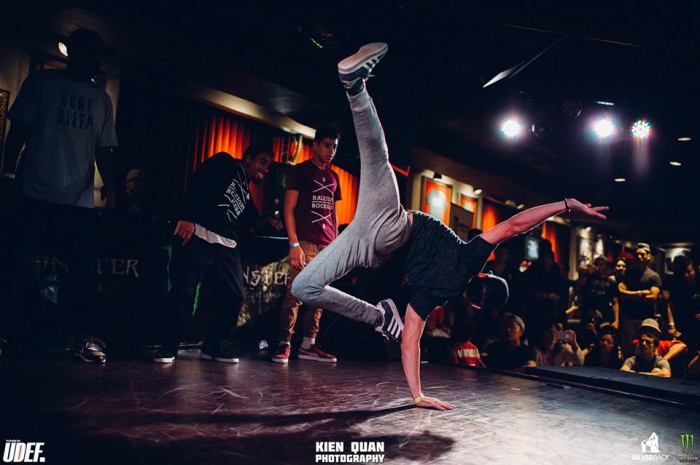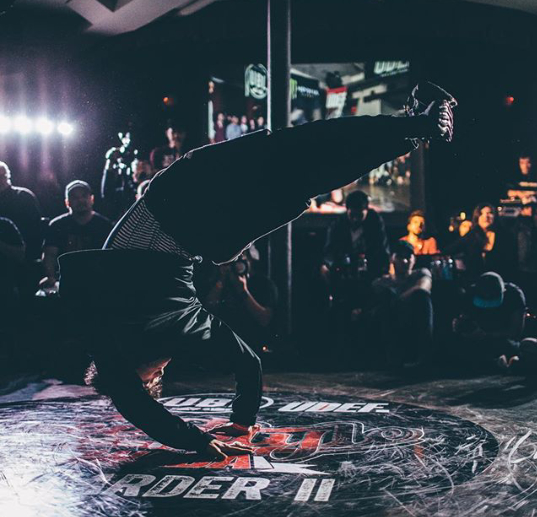
In 2009 I gave a talk on “Break Dance” culture at Hunter College, New York. A student who had taken a few classes around the city raised his hand and asked “How come all the breakers I meet are so happy? Why are you guys so happy all the time?” After thinking about this question, it occurs to me that breaking creates an artistic community that allows for individual self-expression but also requires commitment to the greater good of both the breaking community and the larger world where breaking finds its practitioners and audiences. Dancers must be committed to each other, but they must also demonstrate a deep commitment to making the world a better place for everyone.
In the 1980’s the general public was introduced to the phenomenon of break-dancing—young men spinning on their heads, dance battling, and flipping in the streets of New York. However, bboying—or breaking, as the practitioners themselves like to call it—was invented much earlier in the late 1960’s as a mix of Latin and African dances, martial arts, and gymnastics. In other words, the dance and its culture was nothing like its portrayal in the media. While many people still think of breaking as a kitsch 80’s thing (cardboard, white gloves, abandoned warehouses), the dance has a deep and positive philosophy and a vibrant community. Today, that community is stronger than ever (more than a million people worldwide) in part because of the value placed in virtue and self-transcendence. As we shall see, breaking culture is profoundly Aristotelian.
Aristotle believed that human beings should work towards their own happiness to have a meaningful life. However, the word happiness was used differently then. In contemporary English a Chai Latte, or a the newest iPhone might make us “happy”, but that kind of happiness is fleeting, and bound up in consumerism. Aristotle’s use of the word happiness–“eudaimonia”–translates much more as something like “human flourishing.” Happiness is not a quick fix, but a process down the long road of self-cultivation and hard work. In other words, there is a huge difference between being a human that is merely happy and a human who is truly flourishing.
Aristotle’s notion of virtue and breaking culture both agree that human flourishing requires the cultivation of virtue (also sometimes called good habits or dispositions). Breaking culture in the 1970’s realized much as Aristotle did back in 400 BC that the road to true flourishing is a form of balance between excessive and insufficient character traits. Take learning the back-flip as an example. In order to learn such a stunt a person must be courageous. However, too much courage is being brash, and the brash person will throw themselves into the flip without preparation and technique. This will more than likely lead to a serious injury. However, a deficiency of courage—cowardice—will make it hard for the dancer to learn anything as difficult as a backflip. The fear factor has to be overcome. A cowardly dancer is a bad dancer, but breakers and Aristotle alike would also agree that such a dancer is a person lacking in good character.
In fact, the four most important virtues described by Aristotle (courage, temperance, wisdom, justice), are vital to becoming the perfect bgirl/bboy. Next I will show how wisdom and temperance (self control) are integral parts of the dance, and finally move on to justice. But to understand the wisdom of breaking one must also understand its basic history.

As the result of fiscal and political neglect, the South Bronx of New York City was one of the most abandoned and dangerous neighborhoods in the U.S during the 60’s and 70’s. The construction of the Cross Bronx Expressway, spearheaded by Robert Moses, had displaced more than 60,000 people and created an economic and humanitarian crisis. Gang war was rampant, drugs flooded the streets, and it was more beneficial for landlords to burn down their own buildings to collect insurance money than to keep tenants (hence the phrase “the Bronx is burning”).
It was out of these dystopian conditions that breaking emerged as part of the art form and social movement we know today as Hip-hop. Breaking became an outlet for young men and women to express their creativity, energy, and anger. The flashy acrobatic dance that most people know from TV shows and music videos started as a response to poverty, racism and abandonment. It is therefore not surprising that Breaking has philosophical answers about how to overcome those problems.
Breaking as a belief system is still very much an oral tradition. Every bboy/bgirl has one or more mentors that pass down the history and philosophy of the movement. Even though much has been written on the history of breaking, not much has been written on its philosophy (with the exception of Foundation by Joseph Schloss which I highly recommend). The mentors not only teach the next generation their movements and history, they also pass down important life lessons. The emphasis put on passing down the knowledge of how to overcome society through dance, makes wisdom a key virtue of breaking culture.
Every bboy/bgirl must move from being seen as a social stereotype to being recognized as an individual. A successful bboy or bgirl must be unapologetically themself. How is this achieved? By cultivating the virtues of creativity, discipline, courage, humility empathy, and wisdom. A practitioner with these virtues has all the tools to express herself fully. In other words, the virtues lead to a form of liberation through dance. But even with courage, creativity and wisdom in place, spinning on the ground or flying through the air is still extremely difficult. There must be an organizing principle to it all. Temperance is therefore an integral virtue of breaking. Without self-discipline at most one can hope to achieve are some spasms on the ground.

Breaking culture measures how successful each member is at practicing the virtues by holding intense competitions known as “battles”. This happens formally through organized competitions, but more importantly, informally, in dance circles known as “Cyphers”. The more battles that are won, the more a breaker has testimony that they have achieved individuality and thereby liberation from social constraints.
Although breaking puts a lot of emphasis on the flourishing of the individual, community is in fact the most important aspect of the dance. Which brings us to the final of our four Aristotelian virtues, namely justice in the context of a self-transcendent aim. Aristotle sees justice not only as a way of acting towards particular cases, but also as a way of acting towards one’s community. The ethos of breakdancing orients each of its practitioners towards each other and the larger world in a self-transcendent way that makes breakdancing about making the world a better place for everyone.
Each of the mentioned breaking virtues—courage, temperance, wisdom, justice– are supposed to be cultivated in a community-oriented manner. A successful bboy/bgirl must “pay their dues” by contributing to the community at large. The oral history must be continued, techniques must be taught and preserved, but most importantly, opportunity must be created for all members of the community. In other words a strong sense of justice serves as the motivating factor behind the enterprise of breaking. As a community at large breakers must move from few life opportunities to many, and it is the responsibility of the practitioners to create these opportunities for one another.
From the outside, breaking appears to be highly driven by competition, but actually opportunity building is at the core of its philosophy. The 1984 song Peace, Unity, Love and Having Fun, by Afrika Bambaataa, is emblematic of a deeper current of thinking found in breaking and the Hip-hop movement at large. The four breaking goals of Peace, Unity, Love, and having Fun are only achieved when members of the community provide opportunity for one another. Hence the slogan “Each one, teach one” was adopted by breakers to not only refer to technical skill, but also to encourage care about fellow practitioners. This notion extends from passing on job opportunities to fund-raising for community members to paying their medical bills. For example, in 2016, the U.S breaking community came together to save the spouse of a dancer by raising money for her chemotherapy.
The demand to go above and beyond oneself and care for the larger community is explicitly repeated not only by mentors, but at most breaking events. In fact, the community emphasis is so strong and explicit that it is considered rude and abnormal to turn down a request for free lodging by traveling breakers.
In short, breakers partake in a culture that is centered on the idea of flourishing through the cultivation of self-transcendent virtue, and this orientation means that for them dancing really can change the world. Bboys and bgirls know that their efforts contribute to the continuation of a unique and meaningful culture that artistically and materially helps people spin out of poverty. As with Aristotle, we see in breaking, that a meaningful life, comes with hard work towards the betterment of one’s self; beyond this, breaking’s self-transcendent orientation turns this cultivation of virtue and human flourishing outwards, towards larger communities.
Each one, teach one!
Christian Kronsted is a graduate student assistant with Virtue, Happiness, & the Meaning of Life.